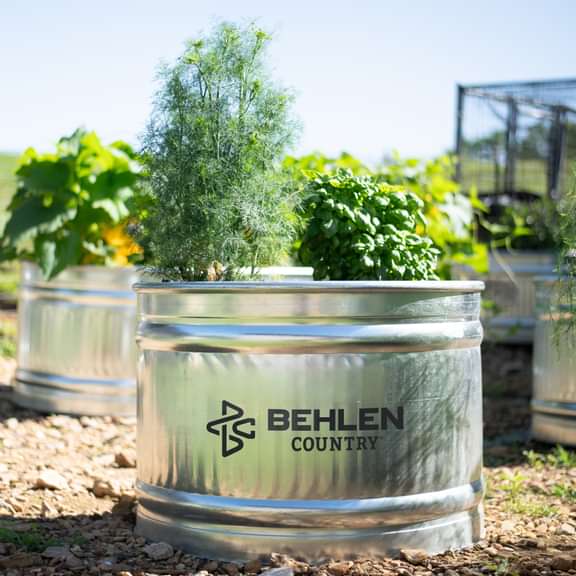What is Galvanized Steel?
Galvanized steel is regular steel coated with zinc to resist rust. It’s common on farms and in backyards because it’s tough, affordable, and long-lasting. Understandably, customers ask two questions a lot:
- “Is it safe to roast hot dogs or marshmallows over a galvanized fire ring?”
- “Is it safe to grow vegetables in galvanized stock tanks or beds?”
Short answer: Yes—with simple best practices. Here’s the why (and the how).
Cooking Near a Galvanized Fire Ring

What the science says:
- Zinc has a melting point of ~419.5°C/787°F and a boiling point (vaporization) of ~907°C/1,665°F. Hazardous zinc fumes (zinc oxide) form when zinc is vaporized—the primary concern in welding or extreme heat scenarios, not everyday camp cooking. Periodic Table
- The CDC/NIOSH describes metal fume fever from inhaling zinc oxide fumes during activities like welding. That’s an occupational exposure scenario with high airborne concentrations—not typical campfire roasting. CDC+1
- Typical campfire cooking heat near flames and embers is often in the hundreds of °F (roughly around ~600°F/320°C in many cooking setups), though core fire temps can be higher. Position and airflow matter. Illinois Extension
Practical guidance for fire rings:
- Roast over the fire, not on the ring. Hold food over the flame/embers with skewers or use a food-safe grate designed for cooking. Don’t place food directly on galvanized metal. (FDA-modeled codes restrict galvanized metal as a food-contact surface with acidic foods; the simple consumer rule is “don’t cook directly on galvanized.”) LawFiles+1
- Distance is safety. Keep food suspended over the heat source (typical roasting position). This uses convective/radiant heat where temperatures are well below zinc’s boiling point and avoids direct contact with galvanized surfaces. Illinois Extension
- Choose the right grate. If you want a grate, use stainless or cast iron marketed for cooking. Avoid makeshift galvanized grates. FDA-aligned codes discourage galvanized food-contact surfaces, especially with moisture/acid. LawFiles+1

Bottom line for s’mores and hot dogs:
Roasting over a wood fire inside a galvanized ring is a common use and generally safe when the food doesn’t touch the galvanized metal and you use a proper cooking grate or skewer. The welding-type fume hazard is a different, much hotter situation. CDC+2NCBI+2
Growing Vegetables in Galvanized Containers

What leaches, and when?
- The zinc coating can slowly release trace zinc under the right conditions. Zinc is a plant micronutrient and naturally present in soils; excessive amounts can be phytotoxic, but that’s uncommon in typical garden soils. University/extension guidance: neutral to slightly alkaline soils leach far less; highly acidic soils (pH < ~5) increase zinc dissolution. University of Minnesota Extension
- Land-grant Extension guidance and expert forums based on Extension input say galvanized stock tanks are generally safe as planters; concerns rise mainly with very acidic soil or old, heavily corroded containers. University of Minnesota Extension+1
- The American Galvanizers Association notes galvanized steel is widely used around the food chain; the main direct-contact caution is acidic foods (because acid speeds zinc corrosion). Gardening soils for vegetables are typically near neutral. American Galvanizers Association
Best practices for stock tank planters
- Aim for soil pH ~6–7. Most vegetables prefer this anyway; it minimizes zinc dissolution and keeps plants happy. (If you grow acid-loving crops like blueberries, consider a non-metal container or line the bed.) University of Minnesota Extension
- Consider a liner. If you want an extra margin (or you’re using composts that trend acidic), line the interior with a heavy-duty pond liner or landscape fabric to reduce direct soil-metal contact and to buffer moisture against the walls. University of Minnesota Extension
- Ensure drainage. Drill/ensure adequate drainage holes and add a coarse base layer for airflow. Good drainage prevents standing acidic water against the walls. (General safe container gardening practice.) UofL
- Avoid very old/peeling containers of unknown history. If a surface is flaking heavily or contains old solders of unknown composition, choose a newer unit or use a full physical liner. (General precaution consistent with food-contact guidance.) UC Food Safety
Bottom line for container gardens:
For typical vegetable soils (near-neutral pH) and good drainage, galvanized planters are generally considered safe for growing produce. If soil must be acidic or you want extra peace of mind, use a liner. University of Minnesota Extension
References
American Galvanizers Association. (2012). Hot-dip galvanizing for corrosion protection: A specifier’s guide. Galvanize It. https://galvanizeit.org/education-and-resources/publications/hot-dip-galvanizing-for-corrosion-protection-a-specifiers-guide-2012
American Galvanizers Association. (n.d.-a). Corrosion protection for steel (hot-dip galvanizing). Galvanize It. https://galvanizeit.org/hot-dip-galvanizing/why-specify-galvanizing/corrosion-protection
American Galvanizers Association. (n.d.-b). Corrosive chemicals & substances in contact with HDG steel. Galvanize It. https://galvanizeit.org/knowledgebase/article/corrosive-chemicals-and-galvanizing
American Galvanizers Association. (n.d.-c). HDG food & beverage processing facilities. Galvanize It. https://galvanizeit.org/education-and-resources/publications/hdg-food-and-beverage-processing-facilities
American Galvanizers Association. (n.d.-d). In contact with food. Galvanize It. https://galvanizeit.org/hot-dip-galvanizing/how-long-does-hdg-last/contact-with-food
Ahsan, S. A., Lackovic, M., Katner, A., & Palermo, C. (2009). Metal fume fever: A review of the literature and cases reported to the Louisiana Poison Control Center. Journal of the Louisiana State Medical Society, 161(6), 348–351. https://ldh.la.gov/assets/oph/Center-EH/envepi/occ_health/Documents/Metal_Fume_Fever_LSMS_article.pdf
Food Protection Committee. (2012). Use of galvanized metal with acidic foods (Issue I_027). Conference for Food Protection. https://www.foodprotect.org/issues/packets/2012packet/issues/I_027.html
Henlex. (2020, June 5). Welding fume hazards: A closer look at galvanized steel. Henlex. https://www.henlex.com/welding-fume-hazards-a-closer-look-at-galvanized-steel
National Center for Biotechnology Information. (2023). Metal fume fever. In StatPearls. StatPearls Publishing. https://www.ncbi.nlm.nih.gov/books/NBK583199
Wardhana, A., Pratomo, H., Soemantri, S., & Sutrisna, B. (2014). Metal fume fever among galvanized welders. Acta Medica Indonesiana, 46(4), 291–298. https://pubmed.ncbi.nlm.nih.gov/25348190

